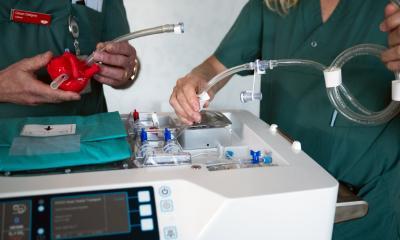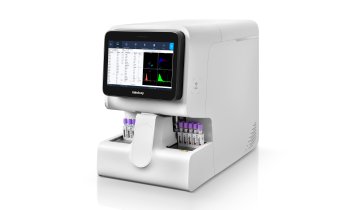Image source: Adobe Stock/bittedankeschön
News • Extracorporeal photopheresis
Study on ECP in heart transplant patients presents promising results
Results from the largest European and first multicenter, retrospective, observational chart review study investigating the real-world use of extracorporeal photopheresis (ECP) in heart transplant patients reinforce its use as a treatment for heart transplant rejection and prevention of rejection.
Global specialty pharmaceutical company Mallinckrodt plc announced the publication of findings from a retrospective, observational, single arm, European chart review study assessing the real-world use of ECP and its impact on clinical outcomes in the modern era of heart transplantation.1 An online version of the data manuscript – the largest-known study of ECP in heart transplant patients – is currently published on the Journal of Heart and Lung Transplantation website in advance of print publication in the second half of 2023. Interim results of this study were presented in a late-breaking session at the 20th Congress of the European Society for Organ Transplantation (ESOT) in 2021 in Milan, Italy.
These findings [...] support ECP as a treatment for various types of graft rejection and in prevention of graft rejection with varied treatment schedules
Markus Barten
The study examined data from the medical charts of 105 patients who received ECP following heart transplantation at seven medical centers in Austria, Germany, France, Hungary, and Italy between 2015 – 2021. At time of data extraction, 58 patients (55.2%) had completed their ECP treatment and 47 patients' (44.8%) ECP treatment was ongoing.
"These findings from the largest European and first multicenter study investigating the real-world use of ECP in heart transplant patients support ECP as a treatment for various types of graft rejection and in prevention of graft rejection with varied treatment schedules," said Markus Barten, M.D., Surgical Director of Heart Failure Clinic, University Heart and Vascular Center Hamburg. "This data not only builds upon the growing body of real-world evidence supporting the use of ECP in heart transplant patients, but also reflects the importance of supporting clinicians with treatment modalities for transplant rejection and stabilization."
About the study
Mean age of patients at start of ECP was 47.7 (SD 14.4) years (min. 16 years to max. 74 years), and most patients (70.5%) were male. They were followed for a mean time of 25.1 (SD 16.8) months from ECP treatment initiation to last visit at the transplant center (follow-up time for outcome overall survival). Mean time from ECP treatment initiation to last visit right censored at 2 years after the end of ECP treatment was 22.5 (SD 13.7) months (follow-up time for outcomes graft function, response, and complications).
Cardiomyopathy was the primary reason for heart transplantation (n=81 patients; 77.1%), followed by coronary heart disease (n=11 patients; 10.5%), heart valve disease (n=5 patients; 4.8%), and myocarditis (n=5 patients; 4.8%). The main reason to start ECP treatment was acute cellular rejection (ACR; n=37 patients; 35.2%), followed by prevention of rejection (n=34 patients; 32.4%), mixed rejection (n=19 patients; 18.1%), and antibody-mediated rejection (AMR; n=15 patients; 14.3%).
The prevention of rejection subgroup included patients who started ECP treatment without biopsy-proven rejection and with standard or reduced immunosuppressive therapy.
Key Findings
- Graft function was stable for almost all patients throughout the study who completed ECP and had graft function change assessed (97.2%; n=35/36).
- In patients who started ECP to treat ACR, AMR or mixed rejection (n=26), completed ECP treatment and had a biopsy at the start and end of treatment, 92.3% (n=24) were classified as responders, having demonstrated an improvement of ACR and/or AMR International Society for Heart and Lung Transplantation (ISHLT) grading after a mean ECP treatment duration of 5.4 months. The remaining patients had stable grades.
- In patients who started ECP to prevent rejection (n=34), 88.2% (n=30) remained free from any rejection over a mean follow-up of 26 months despite being considered at high risk for rejection and reduced immunosuppressive therapy.
- All patients started ECP treatment while on immunosuppressive therapy, and almost all remained on immunosuppressants until last reported visit prior to data extraction. Tacrolimus and mycophenolate derivatives were the most frequently used immunosuppressants. The number of patients on steroid therapy decreased slightly over time.
- Among patients with ongoing ECP treatment who remained on steroid therapy (n=34), steroid dose was reduced on average by 63.0% from start of ECP to last reported visit for 41.2% (n=14) of patients. Steroid dose increased for 5.9% (n=2) of patients and was stable in 52.9% (n=18) of patients.
- Among patients who completed ECP treatment and remained on steroid therapy (n=42), steroid dose was reduced on average by 67.0% from start of ECP to last reported visit for 52.4% (n=22) of patients. Steroid dose increased for 4.8% (n=2) of patients and was stable in 42.9% (n=18) of patients.
- Amongst the 19 patients in the prevention group, 16 (84.2%) received tacrolimus at the start of ECP and last reported visit. In 11/16 patients, tacrolimus trough levels were available of which 7 (63.6%) patients experienced an average trough level decrease of 34.0%.
- Amongst the 19 patients in the prevention group, 14 (70.4%) received mycophenolate derivatives at the start of ECP and last reported visit. In 4/14 patients, mycophenolate doses were available of which 100% of patients remained on stable mycophenolate derivate dose.
- Seventeen of 105 included patients (16.2%) experienced a complication after ECP treatment initiation, the most common of which was infections (n=13, 12.4%). Four of 105 patients (3.8%) experienced an endocrine/respiratory/blood/cardiac disorder, 2 patients (1.9%) an intolerance of high-dose immunosuppressive therapy, and 1 patient (1.0%) an acute kidney injury.
- Overall survival was 95.2% (n=100) over a mean follow-up of 25.1 (SD 16.8) months. Of the 5 deceased patients, 3 (60.0%) died with a functioning graft and 4 (80.0%) died after end of ECP treatment. No deaths were related to ECP.
- No major safety events occurred. Eighteen of 105 included patients (17.1%) had at least one ECP-related safety event, the most common of which was complications with venous access (n=13; 12.4%). Two (15.4%, n=2/13) patients stopped their ECP treatment as a result. Furthermore, 6/105 patients (5.7%) had ECP-related anemia, 3 patients (2.9%) ECP-related hypotension, 1 patient (1.0%) ECP-related fever, and 2 patients (1.9%) had an unspecified ECP-related safety event, but none of them discontinued their ECP treatment as a result.
Limitations
The effectiveness of ECP in comparison with other treatment options was not assessed due to the descriptive, single-arm design of this study. Study limitations include that data generation for this observational study was not standardized. Patient examination schedules varied and not all data were available at all centers. No source data verification was performed and therefore, transmission errors cannot be excluded. Not all demonstrated benefits may be solely attributable to ECP treatment, as transplanted patients may have received multiple therapies at time of ECP treatment. In patients with AMR or mixed rejection, ECP is commonly used in combination with other treatments.
This study was funded by Mallinckrodt.
Reference:
Source: Mallinckrodt
15.06.2023











